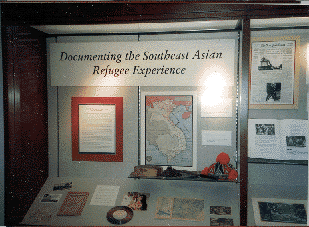
the Southeast Asian Refugee
Experience
REFUGEE: Any person who is outside his or her country of nationality and is unable or unwilling to return to that country because of persecution or a well-founded fear of persecution that may be based on race, religion, nationality, membership in a particular social group, or political opinion.
--Adapted from the Refugee Act of 1980
With the withdrawal of American forces from Vietnam in 1975 and the collapse of the governments of Laos and Cambodia, over two million refugees fled from the former Indochina, fearing Communist reprisals. Although these refugees have resettled all over the world, the largest number (over 1,250,000) have been admitted to the United States, this country's largest refugee group since World War II.
Of the Southeast Asian refugee admissions from 1975-1994, sixty-six percent came from Vietnam. Twenty-one percent are from Laos, with the Hmong and other ethnic peoples from the Laotian highlands comprising slightly less than half of this group. Thirteen percent of the refugees are from Cambodia.
Southeast Asian refugees and immigrants have settled in every state of the Union, but more than forty percent of them, or almost 500,000 people, have made California their new home. Orange County is home to the largest Vietnamese population outside of Vietnam, with Westminster's "Little Saigon" as its heart. Likewise, the largest number of Cambodian refugees have settled in Long Beach. Many Laotian refugees reside in California's Central Valley. Diverse in ethnicity, culture and language, these new Americans are united, however, in their desire to seek freedom and a productive new life in the United States.
In 1987 the UCI Libraries established the Southeast Asian Archive to document the resettlement experiences of refugees and immigrants from the former Indochina, with a special focus on materials pertaining to the large communities established in Orange County and California. The Archive also includes materials relating to Southeast Asian refugee resettlement in other parts of the United States (and to a lesser extent, worldwide), the boat people and land refugees, and the cultures and histories of Cambodia, Laos and Vietnam.
From the beginning, numerous donors and other members of the Southeast Asian communities have been involved in building the Archive. An Advisory Board assists with acquiring materials and funds, as well as supporting and enhancing the Archive's use.
All materials in this exhibit are from the Southeast Asian Archive, and individual donors of materials have been recognized throughout. Documenting the Southeast Asian Refugee Experience was curated by Southeast Asian Archive Librarian Anne Frank.

 |
UCI Libraries Homepage
UCI Homepage |
http://previous.lib.uci.edu/ seaexh/ Copyright 1999, University of California |
UCI Southeast Asian Archive P.O. Box 19557 Irvine, CA 92623-9557 (949) 824-4968 |
